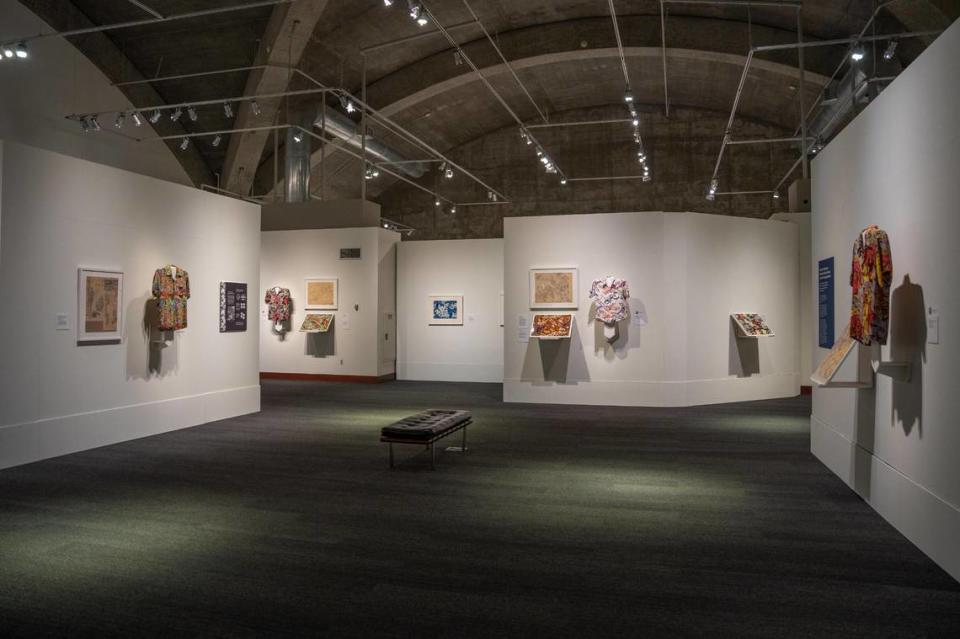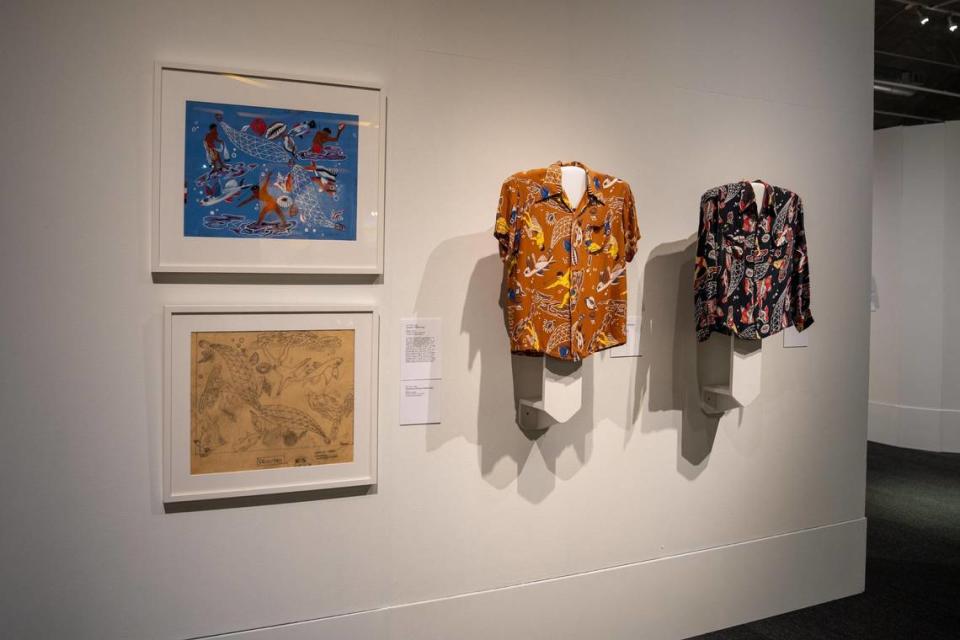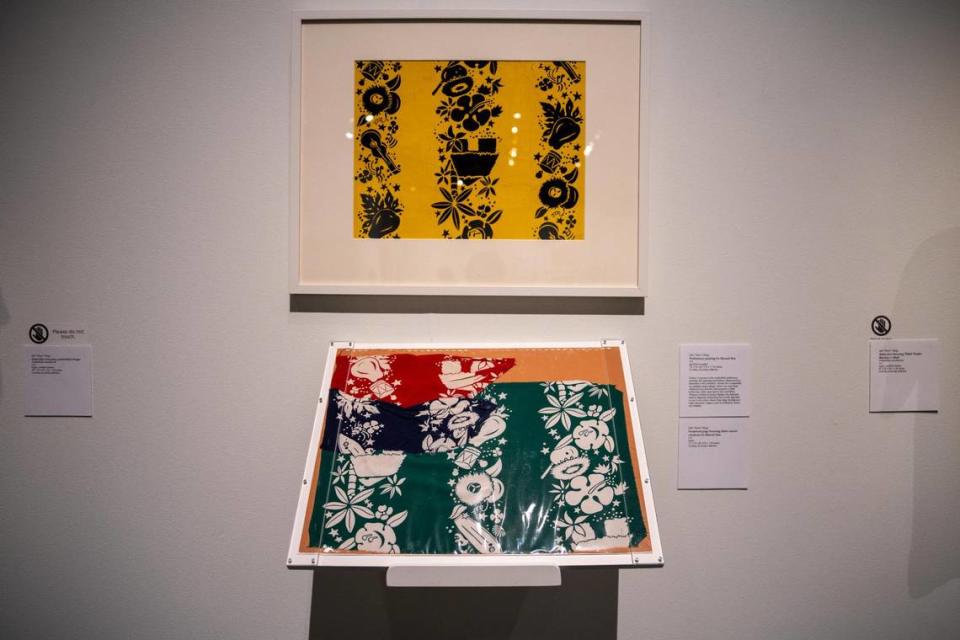Nothing boring about these shirts on display at the WA History Museum through September
David Bader is the perfect person to explain the allure of aloha shirts.
Bader, a Tacoma-based aloha shirt collector, sported his first one before he could form complete sentences; his mom bought him a red shirt patterned with blossoming orchids when he was 2 years old. Since then, Bader, now 63, has been enthralled with the apparel.
He had the opportunity to share both a personal and a cultural aloha-shirt history with The News Tribune in July. On a Friday morning, half an hour before the Washington State History Museum opened, Bader met with the newspaper and three Washington Historical Society employees at “Art of the Aloha Shirt”, a traveling exhibit that lives in Tacoma this summer. As he led the small party around some of his favorites among the 19 shirts on display, he recalled what first attracted him to the attire.

“I just always loved the look,” he told The News Tribune while exploring the exhibit. As he spoke, Bader sported a half-buttoned blue and white patterned aloha shirt, a garment he sewed himself, over a white T-shirt. “Men’s clothing is traditionally very monochromatic and kind of boring. Hawaiian shirts are a departure from that.”
Since childhood, Bader has explored ways to express his love of aloha shirts. He started collecting them when he was in grade school and continued throughout his time at Mount Tahoma High School. When he took a job as an elementary teacher at the Grant Center for the Expressive Arts, he instituted “Aloha Shirt Friday” and encouraged his students to come to school wearing them.
“I’d always find ways to find shirts for my kids if they couldn’t afford them,” Bader said. “Usually about 70% [would participate], but some years they were really into it, and it was close to 100%.”
Now, retired from Tacoma Public Schools and running a vintage textile shop in the city, his enthusiasm has translated into appreciation for an exhibit like the one in the museum. Supplied primarily from the collection of Dan Eskenazi and curated by Dale Hope, the shirts were created as long as eight decades ago.
Celebrating an Aloha Shirt Icon
At the exhibit, he stopped at one with fabric that depicts about a dozen men, each a few inches tall, using spears and fishing nets to hunt marine animals. All of the action takes place in the foreground of a brown background the shade of milk-laden coffee. Its buttons, Bader told the group, are likely made from bamboo or coconut.

To the left of the shirt were two framed artifacts: a sketch, littered with a few small notes on the bottom, and a painting. Both employ the same design as the shirt’s fabric.
Gwen Whiting, a member of the tour party and a curator for the Washington Historical Society, explained that the artifacts were part of John “Keoni” Meigs’ creative process when he designed the shirt.
“That’s really special to have it mapped out,” Whiting said. “You really don’t see that very often, especially in shirts that are almost 80 years old.
Nearly all the shirts on display were sketched, designed and sewn by Meigs. When he transplanted from California to Hawaii in the 1930s, historians believe Japanese women had just started repurposing kimono fabric into men’s shirts, creating the world’s first aloha shirts.
Inspired by these garments and Tahitian art around the islands, Meigs sketched and painted his own designs, replicated the multicolored images onto fabric and sewed them into shirts.
Today, nearly two decades after his death, he is considered one of the art form’s key influential figures.
“He was like on the cutting edge of the industry,” Whiting said. “[He was] working with folks on the island to make his designs come to life.

“At the time the shirts were being made ... you had [on Hawaii] the indigenous people, you had European people, the Japanese community, the Chinese community, Filipino [and] Korean communities, who are all joined together on this island. And the shirts reflect that.”
Thinking about the past in the present
A different shirt highlights a tension that lurks in his work. Like the previous one, a Meigs aloha shirt hangs to the right of two accompanying objects. However, neither of them were designed by Meigs. One is a painting he replicated of a Eugene Henri Paul Gauguin woodcut painting. It depicts some of Gauguin’s experiences in Tahiti, and it was the road map for the shirt’s fabric design.
The other is a blue poster, designed by Whiting. It projects the headline, “What’s the difference between stylistic influence and cultural appropriation?” It is one of a few blue posters Whiting made to add context to the displays.
Meigs moved from the mainland to Hawaii, and Gaugin from France to Tahiti. Both incorporated the ethnic traditions from groups neither were a part of into their creative works and portrayed the cultures throunugh a Western lens. But, as Whiting wrote on her poster, Meigs and Gaugin were not aware of the pitfalls of cultural appropriation when they created their art.
“It’s one of the things we have offered questions throughout the exhibition to invite people to think about that, in what light do you consider these works?” Whiting said. “There’s questions, [but] there’s really no one answer to any of this.”

“It’s difficult,” Bader said. “I like to think of it as this idea of...communities coming together to create something beautiful. So that’s the only way I can think about it.”
He plans to discuss such topics when he speaks at an Aug. 18 event at the exhibit. In addition to Bader’s talk, the historical society invited Washington State University professor emeritus Linda Bradley and cocktail historian Renée Cebula to give presentations related to the aloha shirts.
While looking forward to the other guest speakers, Bader hopes to see some of the now-grown up elementary school students who participated in Aloha Shirt Friday a few decades ago.
“Since I taught in the community where I live, a lot of the kids have become friends,” Bader said. “So I should probably see a lot of them here.”
‘Art of the Aloha Shirt’
▪ Where: Washington State Historical Museum
▪ When: Now until Sept. 11, 2022
▪ Pricing: $14 for a museum ticket (available online or at the front desk)
▪ Free community event Aug. 18, 6-8 p.m.

